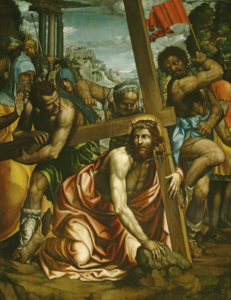At the dawn of the 16th century Mannerism was gaining in popularity. Even noted Renaissance painters like Raphael began to mirror the style, but it was the Sienese painter Giovanni Antonio Bazzi who would push the mannerist vision even further.
Tag Archives: Il Sodoma
Procession to Calvary
Oil on Panel
Giovanni Antonio Bazzi, called Il Sodoma
Sienese, c. 1477-d. 1549
The life and times of Giovanni Antonio Bazzi (1477-1549), better known simply as Il Sodoma, were filled with tumultuous events and dramatic historical change. Born under the auspices of the Renaissance in 1477, Bazzi lived during the apex of the High Renaissance style in art only to witness the style’s demise with the sacking of Rome in 1527.Bazzi contributed greatly to High Renaissance elegance, introducing the movement’s harmonious compositions and dignified, lifelike characters to his home city of Siena, Italy. In 1508, he had the good fortune to travel to Rome, where Pope Julius II commissioned him to assist in the painting of the Stanza della Segnatura in the papal rooms of the Vatican. Here, he worked with the incomparable Raphael Sanzio—who, as fortune would have it, was working in the same room!
Bazzi’s painting reflected the historical trends of his time, as the High Renaissance style that he made famous in Siena gradually intermingled with a new, more daring movement— Mannerism. Nowhere is this blending more evident than in his 1525 work, Procession to Calvary found in M&G’s collection. In his painting, Bazzi combines the sfumato styling of Leonardo da Vinci with direct references to Raphael’s 1520 altarpiece, Christ Falling on the Way to Calvary.
However, Bazzi’s Procession moves stylistically beyond both master painters by employing full-blown characteristics of the Mannerist movement, including use of bright and garish colors, character’s featuring extreme body contortions and theatrical poses, and close cropping around the painting’s edges. As M&G former curator John Nolan writes, “The bodies of the tormentors writhe in their effort to scourge Christ. Their awkward poses add to the tension of the scene.”
Bazzi was disliked by Renaissance art historian Giorgio Vasari (1511-1574), who wrote critically of him in his famous Lives of the Most Excellent Painters, Sculptors, and Architects (1550). As such, Bazzi’s immediate reputation suffered; however, taken together with his 1525 work entitled St. Sebastian, this period in Bazzi’s life was among his greatest in terms of artistic production, with this Procession rightly deserving recognition as one of Bazzi’s most exquisite masterpieces.
Published in 2013
